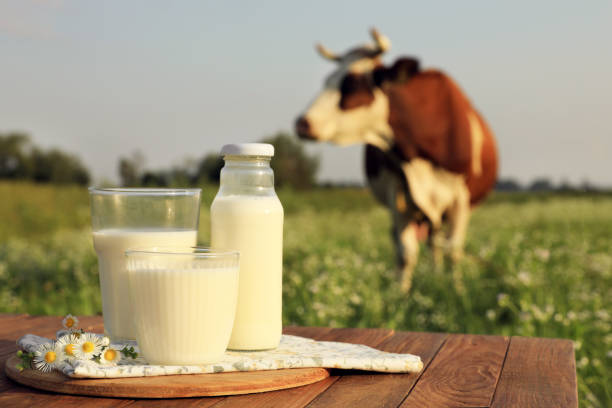
"How to Improve Milk Flavor Naturally: Unlocking the Secrets to Rich, Creamy, and Fresh-Tasting Milk Without Chemicals"
Discover natural ways to enhance milk flavor, ensuring a rich, fresh taste through sustainable farming practices, diet adjustments, and careful handling – all without relying on harmful chemicals or additives.
🐶 Pet Star
54 min read · 14, May 2025

Introduction: Why Milk Flavor Matters
Milk is a staple in many diets around the world, consumed in various forms such as fresh milk, cheese, butter, and yogurt. Despite its ubiquity, the flavor of milk can vary greatly depending on several factors, including the breed of the cow, their diet, and the conditions in which they are raised. While modern farming practices and technological advancements have contributed to greater consistency and convenience in milk production, the flavor of milk is often influenced by the practices and conditions under which the cows are raised.
Consumers today are increasingly seeking more natural, high-quality dairy products. There is a growing demand for milk that is fresh, rich, and free of artificial additives, preservatives, and flavor enhancers. Improving milk flavor naturally, without resorting to chemicals or synthetic agents, is an area that both small-scale dairy farmers and large dairy producers can benefit from. This article will explore various ways to enhance the flavor of milk in an environmentally responsible and health-conscious manner.
We’ll dive into the factors that affect milk flavor, focusing on the cow's diet, farming methods, and milking practices, all of which contribute to producing the best possible milk naturally.
The Science Behind Milk Flavor
Before delving into how to improve milk flavor, it’s important to understand what influences milk's taste in the first place. The flavor profile of milk is the result of complex interactions between its physical properties, the cow's diet, genetics, and handling methods post-milking.
The Role of Cow Diet in Milk Flavor
The diet of dairy cows is one of the most significant factors in determining the flavor of their milk. Cows consume a variety of feed, from grass and hay to silage, grains, and by-products. What cows eat directly impacts the composition of their milk, especially its fat content, protein levels, and overall flavor.
- Grass-fed vs. Grain-fed: Grass-fed cows typically produce milk with a more robust, earthy flavor. This is due to the presence of higher levels of omega-3 fatty acids and conjugated linoleic acid (CLA), both of which contribute to a distinct taste. Grass-fed milk has a slightly yellow hue due to the increased beta-carotene content in the grass.
- Grain-fed cows: Grain-fed cows, on the other hand, often produce milk with a milder, creamier flavor. This is because the diet of grains like corn leads to an increased production of certain fatty acids that contribute to a smoother, less pronounced taste.
When cows are allowed to graze on fresh pasture, their milk tends to have higher levels of beneficial fats and nutrients, contributing to a richer flavor. Conversely, cows that are fed grain-based diets might produce milk that tastes bland or even slightly sour, depending on the quality of the grain used.
The Impact of Forage Quality
Beyond the basic components of the cow's diet, the quality of forage, such as fresh grass or hay, plays a significant role in the milk's flavor. The nutritional content of forage, including its levels of fiber, protein, and minerals, will influence the production of milk and its overall taste.
- Fresh Grass: Cows grazing on fresh, high-quality grass produce milk with a more complex flavor profile, with subtle grassy, nutty, and earthy notes.
- Hay or Silage: When fresh grass is unavailable, cows are typically fed hay or silage, which are fermented and preserved. Silage, in particular, can introduce a tangy or even slightly sour flavor to the milk due to its fermentation process.
Farmers can enhance milk flavor by ensuring cows are fed high-quality forage, particularly during the peak grazing season, when fresh grass is at its nutritional best.
Sustainable Farming Practices for Better Milk Flavor
While the diet of the cow plays a major role in milk flavor, the broader farming practices also contribute significantly to the overall quality of the milk. Sustainable, natural farming methods promote not only the health of the cow but also the health of the land, water, and local ecosystems.
Organic Farming and Milk Flavor
Organic farming practices, which exclude synthetic pesticides, fertilizers, and genetically modified feed, can significantly impact the flavor of milk. Organic dairy farmers emphasize pasture-based systems, where cows graze on natural grass and forage, contributing to a fresher, more vibrant taste in their milk.
- No Synthetic Additives: Without the use of synthetic fertilizers and pesticides, organic milk tends to have fewer off-flavors, providing a cleaner and fresher taste.
- Biodiversity in Pastures: Organic farms often maintain diverse ecosystems, which can result in cows consuming a wider variety of plants. This diversity translates into more varied and complex flavors in the milk they produce.
By encouraging biodiversity and minimizing chemical input, organic farming helps create a more natural, flavorful milk product.
Rotational Grazing for Flavor Enhancement
Rotational grazing is a practice where cows are moved to different pasture areas regularly to allow the grass in each area time to recover. This method ensures that cows have access to fresh, nutritious grass throughout the grazing season. Additionally, it helps prevent overgrazing, which can deplete the quality of the pasture and affect the milk’s flavor.
- Fresh Grazing Promotes Nutrient-Rich Milk: Regular rotation not only keeps the cows healthy and the pastures lush but also improves the nutrient profile of the milk, which can enhance its taste.
- Avoiding Overgrazing: By preventing the grass from being overgrazed, rotational grazing helps preserve the diversity of the pasture and its natural flavor profile.
This practice is a great way to naturally improve milk flavor while also maintaining the sustainability of the farm.
Cow Comfort and Its Effect on Milk Quality
Cows that are well cared for and comfortable in their environment are more likely to produce high-quality milk. Stress, poor living conditions, and overcrowding can negatively affect milk production, leading to off-flavors, reduced milk yield, and lower nutritional quality.
Reducing Stress for Better Milk Flavor
Stress in cows can lead to increased levels of cortisol and other stress hormones in the milk, which can alter its flavor. Cows that are stressed or uncomfortable may also produce milk with higher levels of lactic acid, giving it a sour or unpleasant taste.
- Comfortable Housing: Providing cows with spacious, clean, and comfortable living conditions is essential for improving milk flavor. This includes ensuring proper ventilation, clean bedding, and access to clean water.
- Proper Handling: Gentle, calm handling during milking reduces stress and ensures higher-quality milk that tastes fresher and creamier.
When cows are comfortable and stress-free, their milk is less likely to have undesirable flavors, making it taste more pleasant and natural.
Milking Practices and Their Role in Flavor
How milk is handled after it’s been produced is just as important as how it is produced. From the moment it’s drawn from the cow to the point it reaches the consumer, proper handling ensures that milk retains its natural flavors without any unwanted alterations.
Cleanliness and Freshness Matter
Milk is a perishable product, and maintaining its freshness is crucial to preserving its natural flavor. The cleanliness of the milking environment, the equipment used, and the methods of storage all play a part in how fresh and flavorful the milk remains.
- Sanitization of Equipment: Proper cleaning of milking machines, storage tanks, and utensils is essential to avoid introducing any off-flavors or contaminants into the milk.
- Immediate Cooling: After milking, the milk should be rapidly cooled to prevent bacterial growth, which can lead to sour flavors. Quick cooling helps maintain the milk’s natural taste.
Minimal Processing for Optimal Flavor
Many commercial dairies subject milk to heavy processing, including pasteurization, homogenization, and fortification, all of which can alter its flavor. While pasteurization is necessary for safety reasons, the other processes can strip milk of its natural taste.
- Low-Temperature Pasteurization: Using lower-temperature pasteurization methods, such as the low-temperature, long-time (LTLT) method, helps preserve milk’s natural flavor while ensuring it is safe for consumption.
- Avoiding Homogenization: Homogenization, which breaks down milk fat into smaller particles, can affect milk’s texture and flavor. Non-homogenized milk retains its natural creaminess and taste.
Minimizing the processing of milk can help preserve its natural, rich flavor, making it taste fresher and more authentic.
The Role of Breeding in Milk Flavor
The breed of cow can significantly influence milk flavor. Different breeds produce milk with distinct characteristics, from taste and texture to fat content. Selecting the right breed for milk production can be key to improving the flavor of milk.
Heritage Breeds vs. Commercial Breeds
Many small-scale farmers and artisanal dairy producers are returning to heritage breeds of cows, which often produce milk with richer, more complex flavors. These breeds have been selected over generations for qualities like milk production, butterfat content, and flavor.
- Jersey Cows: Jersey cows, known for their high butterfat content, produce milk that is rich, creamy, and slightly sweet.
- Guernsey Cows: Guernsey milk is known for its deep golden color and distinctively rich, buttery flavor due to its higher concentration of beta-carotene.
Choosing the right breed for milk production, depending on the desired flavor profile, is another way to naturally enhance milk’s taste.
The Impact of Seasonal Changes on Milk Flavor
Another often-overlooked factor that affects milk flavor is the seasonality of the cows' diet. Throughout the year, the nutritional quality of the pasture and the types of grasses and plants available for grazing can change, influencing the flavor of milk. Understanding these seasonal shifts and how they affect flavor can help farmers optimize the taste of their milk production year-round.
Spring and Summer: Fresh Grass and Rich Flavor
During the spring and summer months, pastures are lush with fresh grass, which provides cows with the richest, most nutrient-dense feed. The increased intake of fresh grasses, herbs, and wildflowers enhances the flavor of the milk, making it taste more vibrant and complex. The higher levels of omega-3 fatty acids, carotenoids, and phytonutrients in fresh grasses contribute to milk's distinct, grassy, and slightly sweet flavor.
- Fresh Grass Flavor Profile: During this time, the milk produced by cows grazing on fresh pasture is often richer, creamier, and more aromatic, with subtle earthy, grassy, and floral notes.
- Increased Beta-Carotene: Fresh grass contains higher levels of beta-carotene, a natural antioxidant, which can also deepen the yellow color of the milk. This can make the milk taste more like the rich, wholesome dairy products people often crave.
Farmers can capitalize on the flavor enhancement that comes with these seasonal changes by ensuring cows have access to high-quality, well-maintained pastures and rotational grazing systems that maximize the intake of fresh forage.
Fall and Winter: Challenges and Flavor Shifts
As the weather cools and grazing becomes less plentiful, cows typically rely more on stored forages such as hay and silage. While these feeds can be nutritious, they can also have a different impact on milk flavor. Silage, in particular, is fermented, and although it provides essential nutrients, it can also introduce tangy, fermented flavors to the milk.
- Fermentation Effects on Milk Flavor: Silage can sometimes result in milk that tastes slightly sour or "off." However, the overall impact depends on the quality of the silage and the balance of its ingredients.
- Maintaining Pasture Quality in Fall and Winter: If cows are fed poor-quality hay or silage that has been improperly stored, it can lead to undesirable flavors in the milk. Therefore, it is essential to maintain proper hay storage techniques and ensure that the forage quality remains high even during colder months.
Farmers may need to supplement cows’ diets with more concentrated feed or other forage options during these months to help maintain flavor consistency and prevent sourness.
The Role of Milking Time and Handling Techniques
The way milk is handled immediately after it is collected plays a crucial role in preserving its flavor. Proper milking practices and techniques can greatly reduce the risk of introducing any unpleasant tastes or odors into the milk.
Time of Milking and Flavor Preservation
The timing of milking can also influence the taste of milk. Milking cows early in the morning, before they have had the chance to graze, can result in milk that has a more subtle flavor, as the cows' stomachs are empty and the milk is fresher. On the other hand, milking after the cows have been grazing may produce milk with stronger, more pronounced grassy flavors due to the higher intake of fresh grass.
- Morning Milking: Many dairy farmers prefer to milk cows early in the morning when their systems are fresh and their milk is at its purest. This can help produce milk with a clean, sweet taste, without the influence of any strong pasture flavors that might be more noticeable later in the day.
- Evening Milking: Milking later in the day, when cows have consumed more grass or other feeds, may yield milk that has richer, more earthy or grassy notes.
Farmers can experiment with the timing of milking to optimize the milk's flavor profile depending on the specific tastes they want to highlight in their dairy products.
Sanitation and Milk Handling Practices
Cleanliness is paramount when it comes to maintaining the flavor of milk. Any contaminants or residues left in the milking equipment can negatively affect the milk’s taste, potentially introducing off-flavors that are unpleasant for consumers.
- Clean Milking Equipment: Milking machines, pipes, and storage tanks must be thoroughly sanitized after every milking session to prevent bacteria or spoiled milk residues from tainting fresh milk. Even small amounts of soap or detergent residue can result in unpleasant flavors.
- Proper Cooling: Milk should be immediately cooled after milking to slow bacterial growth. The longer the milk is left at room temperature, the more likely it is to develop undesirable flavors. Rapid cooling to a temperature of 40°F (4°C) or lower helps preserve the milk’s natural taste.
The faster and more efficiently milk is handled post-milking, the better its overall quality and flavor will be when it reaches the consumer.
Incorporating Natural Flavors into Dairy Products
For those interested in taking their milk’s flavor to the next level, incorporating natural flavorings into dairy products such as cheese, butter, and yogurt can enhance the milk's inherent qualities. This approach uses ingredients that complement, rather than overpower, the milk's natural flavors.
Infusing Milk with Herbs and Spices
Farmers and artisans have long experimented with adding herbs and spices to their dairy products to create unique, flavorful variations. While the primary goal is to enhance the natural flavors of the milk, herbs and spices can also add subtle notes that elevate the taste experience.
- Herb-Infused Butter: One example is the production of herb-infused butter, where fresh herbs like rosemary, thyme, or basil are added to the butter while it’s being churned. This creates a creamy butter with hints of the herbs' fragrant oils and flavors.
- Flavoring Cheese Naturally: In cheesemaking, herbs, flowers, and even fruit can be incorporated into the curd or rind of the cheese. These additions can help highlight and enhance the natural flavors of the milk.
By using fresh, local, and organic ingredients, dairy producers can create a product that offers natural, wholesome flavors that complement the original taste of the milk.
Fermentation and Cultured Dairy Products
Fermentation is another natural method to enhance milk flavor, as it introduces complex, tangy, and umami notes that enrich the overall taste. Cultured dairy products like yogurt, kefir, and certain types of cheese rely on the fermentation process, which can improve both flavor and texture.
- Yogurt: The fermentation of milk with live cultures produces a creamy, tangy yogurt that is full of probiotics and flavor. The specific strains of bacteria used in yogurt production influence its taste, with some adding milder, sweeter notes and others contributing a sharper, tangier flavor.
- Kefir and Other Cultured Dairy Products: Kefir, a fermented milk drink, is rich in beneficial bacteria that not only enhance the milk's nutritional value but also add a slightly effervescent, tangy flavor that many people find refreshing.
These traditional methods of dairy production contribute to natural flavor profiles that are both healthy and delicious.
Conclusion
In conclusion, enhancing the flavor of milk naturally without relying on chemicals or additives is not only possible but also deeply rewarding. By focusing on sustainable practices such as providing cows with a diverse and healthy diet, ensuring they are comfortable and stress-free, and adopting natural farming techniques, farmers can significantly improve the taste and nutritional profile of their milk. Factors like pasture quality, grazing methods, and milking practices all contribute to producing milk that is fresher, richer, and more flavorful.
The growing demand for organic and chemical-free dairy products reflects a larger shift toward mindful consumption. Consumers are increasingly looking for milk that offers not just better taste but also a more ethical and sustainable production process. By prioritizing these natural methods, dairy farmers can produce high-quality milk that meets these expectations while ensuring the welfare of both the cows and the environment.
Moreover, small changes in farming techniques—such as rotational grazing, incorporating seasonal changes in feed, and using minimal processing—can have a profound impact on the flavor of milk. When combined with careful milk handling and storage practices, the result is a superior product that tastes fresh and pure.
As research and practices continue to evolve, the dairy industry has an opportunity to innovate by embracing natural methods that not only preserve milk's rich flavors but also support a more sustainable and humane approach to milk production. Ultimately, improving milk flavor without chemicals is about understanding and respecting the natural processes that make milk so special, ensuring it remains a wholesome, delicious, and eco-friendly choice for consumers worldwide.
Q&A Section
Q1: How does a cow’s diet impact the flavor of its milk?
A1: A cow’s diet plays a major role in milk flavor. Cows fed on fresh pasture or grass tend to produce richer, more complex milk with earthy, grassy flavors, while grain-fed cows often yield milder milk.
Q2: Can rotational grazing improve milk flavor?
A2: Yes, rotational grazing helps maintain fresh, nutrient-rich grass for cows, which leads to milk with a fresher, richer taste. It also supports sustainable land use, which benefits both cows and the environment.
Q3: What is the impact of using organic farming practices on milk flavor?
A3: Organic farming, which excludes synthetic chemicals and emphasizes pasture-based systems, often results in milk with a cleaner, fresher taste due to the higher quality of forage and the absence of chemical additives.
Q4: Do cows' living conditions affect the flavor of their milk?
A4: Yes, cows that are stressed or uncomfortable may produce milk with off-flavors. Providing clean, comfortable living conditions and handling cows gently leads to better milk quality with a more pleasant taste.
Q5: How do seasonal changes affect the flavor of milk?
A5: Seasonal changes impact the nutritional content of pasture. In spring and summer, fresh grasses provide richer milk with a more complex flavor, while hay and silage in the colder months can introduce tangy or sour notes.
Q6: Can low-temperature pasteurization preserve milk’s flavor?
A6: Yes, low-temperature pasteurization helps preserve milk's natural flavor by minimizing the destruction of delicate compounds that contribute to its taste, while ensuring it is safe for consumption.
Q7: Why is quick cooling important for preserving milk flavor?
A7: Quick cooling after milking prevents bacterial growth, which can sour the milk and degrade its flavor. Rapidly cooling milk ensures it remains fresh and retains its natural taste.
Q8: Does milk from different breeds of cows taste different?
A8: Yes, different cow breeds, such as Jersey and Guernsey, produce milk with distinct flavor profiles. Jersey milk is typically creamier and sweeter, while Guernsey milk has a rich, buttery taste.
Q9: Can adding herbs or spices to milk products enhance flavor?
A9: Yes, infusing milk products with herbs like rosemary or thyme, or using spices in butter or cheese, can enhance the flavor and create unique, complex dairy products with natural, complementary tastes.
Q10: Is fermented milk, like yogurt or kefir, naturally flavored?
A10: Yes, fermentation adds a tangy, slightly effervescent flavor to milk, enriching its taste. Yogurt and kefir, made with live cultures, also provide additional health benefits while enhancing the milk’s natural flavor profile.
Similar Articles
Find more relatable content in similar Articles

How Climate Change Affects Wild and Domestic Animals...
Climate change is dramatically.. Read More

Pets and Mental Health: The Science Behind Emotional H..
Discover the profound impact o.. Read More

How Pets Strengthen Family Bonds...
Pets are more than just compan.. Read More

The Growing Trend of Therapy and Emotional Support Ani..
Exploring the remarkable rise .. Read More
Explore Other Categories
© 2024 Copyrights by rPets. All Rights Reserved.